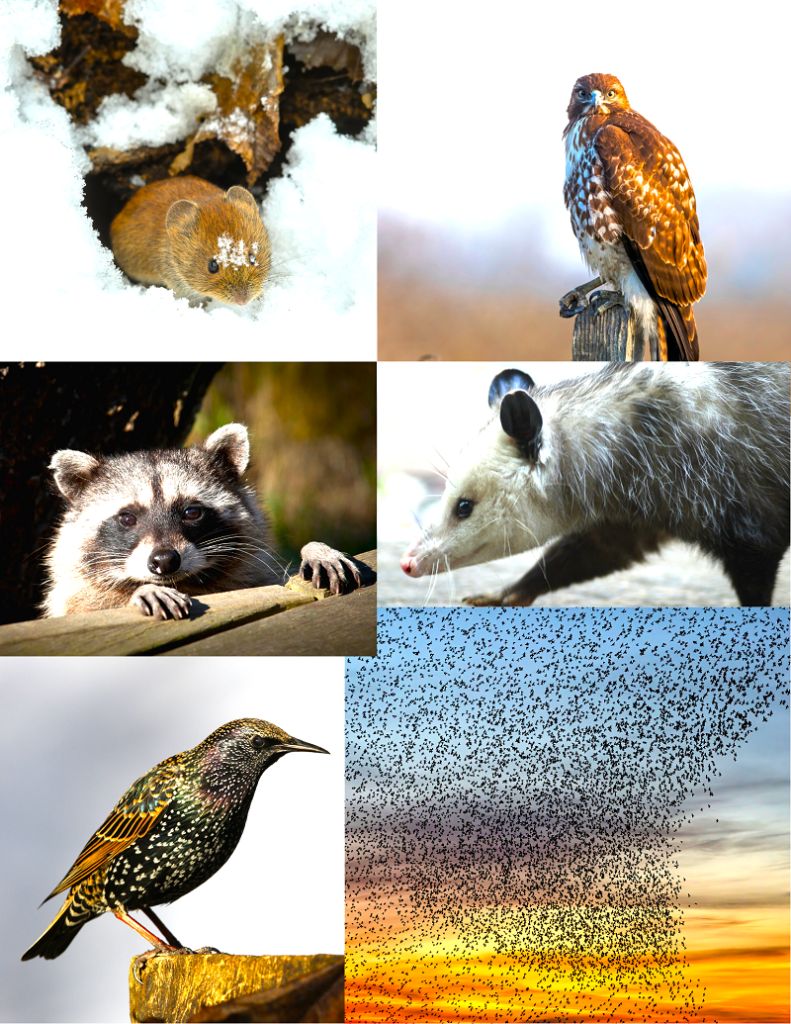Guess who’s coming to dinner…

Ah, the holidays. When families and friends gather. But everyone has one (or some) visitors that come that might not be as welcomed, but more tolerated. This applies to not only your dinner table, but your backyard as well.
And although this issue is more noticed in winter because there is little foliage other than evergreens (or invasive buckthorn or honeysuckle), it really is year-round. I get asked about this all the time. Almost to a surprising level. A more common than not question during the growing season is, “Which flowers attract hummingbirds and butterflies, but not bees?’
This may seem absurd to you. And yes, the answer is, there are none. Bees are the reason we have flowers at all. Without those efficient pollinators, seed-forming plants would eventually cease to be … or should that be “bee?”
A common query in winter is, ‘How do I keep all those (you fill in the blank) starlings, sparrows, finches away from my birdfeeders, so I will get more cardinals, nuthatches and chickadees?”
Again, you can’t. Well, not for the most part.
And even more importantly, how do you stop your birdfeeders from becoming Golden Corral for birds of prey, like the local hawk? This is where you start to sing the Circle of Life song from “The Lion King.”
Then there are the fur-covered visitors whose picture isn’t on that bag of sunflower seed you bought. Sometimes we may wonder, did I buy racoon seed instead?
But seriously, there are some strategies we can employ to deter hawks and other birds of prey, and also make the menus for our wild birds a little more selective (and yes, expensive) to deter those birds that seem to take over the dinner table. And lesser so, but still there are a few anti-racoon and opossum strategies to reduce their presence.
But first, a little positive commercial about our some of these animals that you think are pests. Take hawks and owls. These are meat-eating, laser-sighted, rodent-eating machines. Mostly hawks and, if you are lucky, the owls. Did you know a hawk up on that powerline over 100 feet away can see a mouse?
Not only that, but they can see the urine trails (that reflect in ultraviolet light) that lead the way to these furry snacks, just like an airliner sees a landing strip. Cool, right? Yes, this is nature. And also a great way to have natural rodent control. So, let’s put away that poison. Remember, we create our problems. We poison what we think is the problem, say mice. Let’s say fox eats poisoned mouse; now we have lost a fantastic mouse control. No rodenticides. Period.
For hawks at birdfeeders though, remember, they are big animals, with wide wingspans. They need a clear path to glide in to grab that beautiful cardinal, or fluffy squirrel. So put some physical obstacles between their line of sight and your birdfeeder. I like to recycle those neighborhood Christmas trees that are at the curb by the 26th.
I nestle a few around the feeders and create an obstacle course for the hawk. They choose to go elsewhere, and problem solved. The other advantage to those left-over holiday trees, the birds can use them as shelter if a predator is nearby.
For the clean-up squad as I call them — racoons, opossums and voles — that come overnight to feast on what the birds dropped, you have a few options. One is to get a tray attachment for your tube feeders so less seed falls. Another, more time-consuming, but money-saving option, is to go out and bring your feeders in every night.
I know this sounds like a lot of work, but what you lose in a few minutes of time (it is good to get outside for a few minutes, regardless of the weather, anyway), you will make up in seed cost. Hungry racoons can empty 10 dollars’ worth of expensive seed in a few nights. Taking in feeders may be worth it.
And speaking of seed, although you can’t pick and choose which birds come to the feeders, you can be more selective about the seed choices you make. Avoid that yellow, round seed in the less expensive bird seed mixes at all costs. That is milo. And only blackbirds and starlings like it. Plus it makes for a heck of a weed patch.
But take safflower seed, thistle seed (Nyjer seed). These are appealing to the desirable birds, but less so to the ones you don’t want. Also avoid open platform feeders, and select tube style or better yet, those with feeders inside a “big birds keep out” cage.
And even though I grew up doing it, being from a waste-not, want-not family, get out of the habit of giving table scraps outside. Did you know that feeding bread to birds actually can harm them? Table scraps are also like candy to kids for racoons and opossum.
Try these strategies and your backyard bird population might look a little different soon!
And even though I write this column on my own, our 4-H team has some great activities for kids to do in January. Check these out: